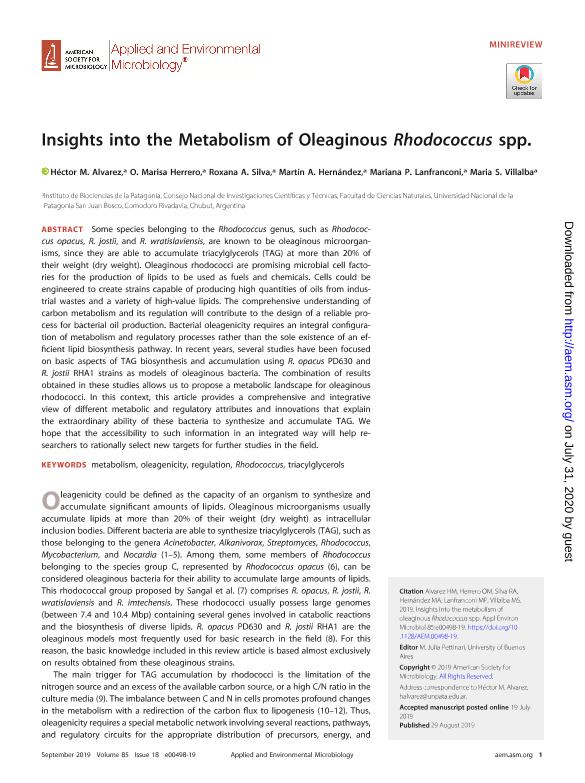Mostrar el registro sencillo del ítem
dc.contributor.author
Alvarez, Héctor M.
dc.contributor.author
Herrero, O. Marisa
dc.contributor.author
Silva, Roxana A.
dc.contributor.author
Hernández, Martín A.
dc.contributor.author
Lanfranconi, Mariana Patricia

dc.contributor.author
Villalba, María Soledad

dc.date.available
2020-07-31T21:49:28Z
dc.date.issued
2019-07
dc.identifier.citation
Alvarez, Héctor M.; Herrero, O. Marisa; Silva, Roxana A.; Hernández, Martín A.; Lanfranconi, Mariana Patricia; et al.; Insights into the metabolism of oleaginous Rhodococcus spp; American Society for Microbiology; Applied and Environmental Microbiology; 85; 18; 7-2019; 1-12
dc.identifier.issn
0099-2240
dc.identifier.uri
http://hdl.handle.net/11336/110700
dc.description.abstract
Some species belonging to the Rhodococcus genus, such as Rhodococcus opacus, R. jostii, and R. wratislaviensis, are known to be oleaginous microorganisms, since they are able to accumulate triacylglycerols (TAG) at more than 20% of their weight (dry weight). Oleaginous rhodococci are promising microbial cell factories for the production of lipids to be used as fuels and chemicals. Cells could be engineered to create strains capable of producing high quantities of oils from industrial wastes and a variety of high-value lipids. The comprehensive understanding of carbon metabolism and its regulation will contribute to the design of a reliable process for bacterial oil production. Bacterial oleagenicity requires an integral configuration of metabolism and regulatory processes rather than the sole existence of an efficient lipid biosynthesis pathway. In recent years, several studies have been focused on basic aspects of TAG biosynthesis and accumulation using R. opacus PD630 and R. jostii RHA1 strains as models of oleaginous bacteria. The combination of results obtained in these studies allows us to propose a metabolic landscape for oleaginous rhodococci. In this context, this article provides a comprehensive and integrative view of different metabolic and regulatory attributes and innovations that explain the extraordinary ability of these bacteria to synthesize and accumulate TAG. We hope that the accessibility to such information in an integrated way will help researchers to rationally select new targets for further studies in the field.
dc.format
application/pdf
dc.language.iso
eng
dc.publisher
American Society for Microbiology

dc.rights
info:eu-repo/semantics/openAccess
dc.rights.uri
https://creativecommons.org/licenses/by-nc-sa/2.5/ar/
dc.subject
METABOLISM
dc.subject
OLEAGENICITY
dc.subject
REGULATION
dc.subject
RHODOCOCCUS
dc.subject
TRIACYLGLYCEROLS
dc.subject.classification
Biología Celular, Microbiología

dc.subject.classification
Ciencias Biológicas

dc.subject.classification
CIENCIAS NATURALES Y EXACTAS

dc.title
Insights into the metabolism of oleaginous Rhodococcus spp
dc.type
info:eu-repo/semantics/article
dc.type
info:ar-repo/semantics/artículo
dc.type
info:eu-repo/semantics/publishedVersion
dc.date.updated
2020-07-01T15:42:42Z
dc.identifier.eissn
1098-5336
dc.journal.volume
85
dc.journal.number
18
dc.journal.pagination
1-12
dc.journal.pais
Estados Unidos

dc.conicet.avisoEditorial
Open Access Policy: Open access across ASM journals
dc.description.fil
Fil: Alvarez, Héctor M.. Universidad Nacional de la Patagonia "San Juan Bosco". Instituto de Biociencias de la Patagonia. Consejo Nacional de Investigaciones Científicas y Técnicas. Centro Científico Tecnológico Conicet - Centro Nacional Patagónico. Instituto de Biociencias de la Patagonia; Argentina
dc.description.fil
Fil: Herrero, O. Marisa. Universidad Nacional de la Patagonia "San Juan Bosco". Instituto de Biociencias de la Patagonia. Consejo Nacional de Investigaciones Científicas y Técnicas. Centro Científico Tecnológico Conicet - Centro Nacional Patagónico. Instituto de Biociencias de la Patagonia; Argentina
dc.description.fil
Fil: Silva, Roxana A.. Universidad Nacional de la Patagonia "San Juan Bosco". Instituto de Biociencias de la Patagonia. Consejo Nacional de Investigaciones Científicas y Técnicas. Centro Científico Tecnológico Conicet - Centro Nacional Patagónico. Instituto de Biociencias de la Patagonia; Argentina
dc.description.fil
Fil: Hernández, Martín A.. Universidad Nacional de la Patagonia "San Juan Bosco". Instituto de Biociencias de la Patagonia. Consejo Nacional de Investigaciones Científicas y Técnicas. Centro Científico Tecnológico Conicet - Centro Nacional Patagónico. Instituto de Biociencias de la Patagonia; Argentina
dc.description.fil
Fil: Lanfranconi, Mariana Patricia. Universidad Nacional de la Patagonia "San Juan Bosco". Instituto de Biociencias de la Patagonia. Consejo Nacional de Investigaciones Científicas y Técnicas. Centro Científico Tecnológico Conicet - Centro Nacional Patagónico. Instituto de Biociencias de la Patagonia; Argentina
dc.description.fil
Fil: Villalba, María Soledad. Universidad Nacional de la Patagonia "San Juan Bosco". Instituto de Biociencias de la Patagonia. Consejo Nacional de Investigaciones Científicas y Técnicas. Centro Científico Tecnológico Conicet - Centro Nacional Patagónico. Instituto de Biociencias de la Patagonia; Argentina
dc.journal.title
Applied and Environmental Microbiology

dc.relation.alternativeid
info:eu-repo/semantics/altIdentifier/doi/http://dx.doi.org/10.1128/AEM.00498-19
dc.relation.alternativeid
info:eu-repo/semantics/altIdentifier/url/http://aem.asm.org/lookup/doi/10.1128/AEM.00498-19
Archivos asociados
